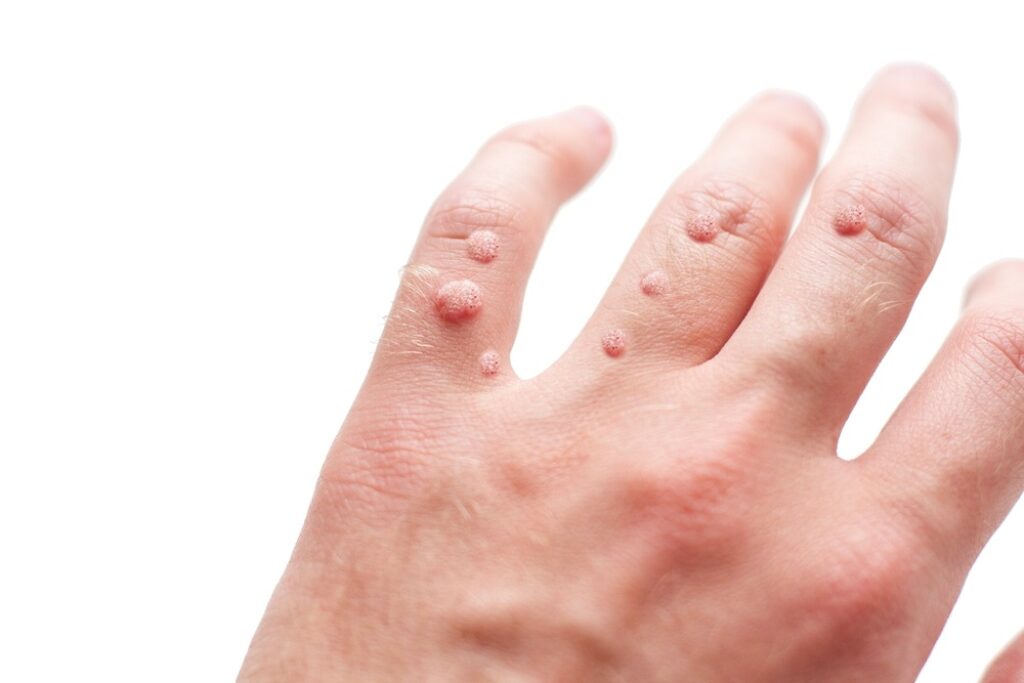
Warts
Have you ever heard of the sweet expression – “I love you, warts and all”? Although the sentence sounds rather cute, warts are anything but pleasant or desirable. Fortunately, there are several treatment options to get rid of them and restore healthy skin to the infected areas.
Related Topics (Sponsored Ads):
Warts are benign (noncancerous) skin growths caused by the human papillomavirus (HPV), a group of more than 100 related viruses. These growths can appear on various parts of the body and are characterized by their rough texture and raised appearance. Warts develop when the virus infects the top layer of skin, often entering through small cuts or abrasions.
While warts are generally harmless, they can be bothersome, particularly if they occur in visible areas or on weight-bearing surfaces like the feet. Understanding the nature of warts, their causes, and their characteristics is essential for effective management and treatment.

Symptoms
Warts can manifest in several forms, each with distinct symptoms and appearances. Common warts (verrucae vulgaris) typically appear as rough, raised bumps on the hands, fingers, or elbows. They may have a grainy surface and can be grayish or brown in color. Plantar warts, found on the soles of the feet, often grow inward due to pressure and may cause pain when walking. These warts can appear flat and may have small black dots, which are clotted blood vessels.
Flat warts are smaller and smoother, often appearing in clusters on the face, arms, or legs. They are usually light brown or yellowish and can be mistaken for other skin conditions due to their subtle appearance. Genital warts, caused by specific strains of HPV, present as small, flesh-colored or gray growths in the genital area and can sometimes resemble cauliflower.
Each type of wart has unique characteristics, making it essential to recognize their specific symptoms for proper identification and management.
Differentiation
As mentioned prior, differentiating warts from other skin conditions is crucial for appropriate treatment. Moles, for instance, are typically uniform in color and shape, whereas warts often have an irregular surface and may vary in color. Skin tags, which are small, soft growths that hang off the skin, differ from warts in that they are usually flesh-colored and do not have a rough texture. Calluses, formed due to repeated friction or pressure, are thickened areas of skin that lack the raised, bumpy appearance of warts.
To identify warts, look for the following characteristics: a rough, raised surface; the presence of black dots (indicative of clotted blood vessels); and a tendency to appear on areas prone to friction or injury. If there is any uncertainty, consulting a healthcare professional for a definitive diagnosis is advisable.
Risk Factors
Several risk factors can increase an individual’s likelihood of developing warts. One of the most significant is exposure to HPV, which can occur through direct skin-to-skin contact or by touching contaminated surfaces, such as public showers or swimming pools. Individuals with weakened immune systems, whether due to illness, medication, or other factors, are at a higher risk for contracting the virus and developing warts.
Certain occupations, such as butchers or healthcare workers, may also increase exposure to HPV due to frequent contact with raw meat or skin lesions. Additionally, children and teenagers are more susceptible to warts, as their immune systems are still developing. Understanding these risk factors can help individuals take proactive measures to reduce their chances of developing warts.
Treatment Options
When it comes to treating warts, several options are available, ranging from over-the-counter (OTC) treatments to more invasive medical procedures. OTC products often contain salicylic acid, which works by peeling away the wart layer by layer. These treatments can be effective, but they may require consistent application over several weeks or months. Cryotherapy, a procedure performed by healthcare professionals, involves freezing the wart with liquid nitrogen, causing it to fall off over time. This method can be effective for various types of warts but may require multiple sessions.
For stubborn warts, laser treatment is an option that uses focused light to destroy wart tissue. While effective, this method can be more costly and may result in scarring. Other medical treatments include cantharidin, a blistering agent applied directly to the wart, and immunotherapy, which stimulates the immune system to fight the virus. Each treatment option has its potential side effects, such as pain, blistering, or scarring, making it essential to discuss these with a healthcare provider to determine the best approach based on the wart type and individual circumstances.
Preventative Measures
Preventing warts involves adopting practical hygiene practices and lifestyle choices. Good hygiene, such as washing hands regularly and avoiding touching warts, can significantly reduce the risk of spreading the virus. Wearing protective footwear in public areas, like swimming pools or locker rooms, can also help prevent plantar warts. Additionally, maintaining a healthy immune system through a balanced diet, regular exercise, and adequate sleep is crucial, as a robust immune response can help fend off HPV infections.
Lastly but equally as important, individuals should avoid sharing personal items, such as towels or razors, which can facilitate the spread of the virus. By implementing these preventative measures, individuals can reduce their risk of developing warts and protect themselves from potential outbreaks.
Final Thoughts
While several treatment options are available, including OTC medications and medical procedures, it is crucial to consult a healthcare professional for personalized advice.
By adopting good hygiene practices and maintaining a healthy immune system, individuals can effectively reduce their risk of developing warts. Seeking medical advice for any concerning skin growths is always recommended to ensure appropriate care and management.




